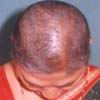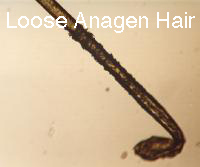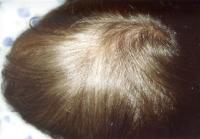Anagen Effluvium Dallas
Anagen Effluvium Hair Loss
Anagen Effluvium
In review, the anagen phase of the hair cycle describes the growth phase of the hair follicle during which time the keratinocytes in the hair matrix are undergoing very high metabolic activity. Chemotherapy drugs that affect the high cell turnover of cancer cells can have direct toxic effects on the rapidly growing anagen hairs, leading to weakening of the hair shaft with abrupt interruption of growth and consequent abnormal breakage patterns along these weakened shafts. Since 90% of scalp hair is typically in anagen phase, there can be considerable loss to the scalp hair during anagen effluvium.  Telogen hairs that are mitotically inactive are spared. Eyebrows and eyelashes are less affected since they have a lower percentage of hairs in the anagen phase. Since hair loss is not dependent on the cycling from anagen to telogen, the effects of anagen effluvium are rapid with breakage occurring within days to weeks following ingestion of a toxin. If the toxin is not as severe with only weakening of the hair shaft and not breakage, Pohl Pinkus lines can appear in which the hair is tapered without actual fracture.
Telogen hairs that are mitotically inactive are spared. Eyebrows and eyelashes are less affected since they have a lower percentage of hairs in the anagen phase. Since hair loss is not dependent on the cycling from anagen to telogen, the effects of anagen effluvium are rapid with breakage occurring within days to weeks following ingestion of a toxin. If the toxin is not as severe with only weakening of the hair shaft and not breakage, Pohl Pinkus lines can appear in which the hair is tapered without actual fracture.
Drug-Induced Anagen Effluvium
|
Asparaginase
|
Idarubicin
|
|---|---|
|
Bleomycin
|
Ifosfamide
|
|
Busulfan
|
Lomustine
|
|
Carboplatin
|
Mechlorethamine
|
|
Carmustine
|
Medroxyprogesterone
|
|
Chlorambucil
|
Melphalan
|
|
Cisplatin
|
Mercaptopurine
|
|
Colchicine
|
Methotrexate
|
|
Cyclophosphamide
|
Mitomycin
|
|
Cytarabine
|
Mitotane
|
|
Dacarbazine
|
Paclitaxel
|
|
Dactinomycin
|
Pentostatin
|
|
Daunorubicin
|
Procarbazine
|
|
Docetaxel
|
Thiotepa
|
|
Doxorubicin
|
Thioguanine
|
|
Etoposide
|
Topotecan
|
|
Fluorouracil
|
Vasopressin
|
|
Gemcitabine
|
Vinblastine
|
|
Hydroxycarbamide
|
Vincristine
|
|
Hydroxyurea
|
Vinorelbine
|
Loose Anagen Syndrome
 Loose anagen syndrome is an inherited disorder that is characterized by premature anagen release. The structural defect lies in the poor binding of the hair shaft cuticle with the inner root sheath cuticle so that with gentle traction during the hair pull test, the anagen hairs are easily removed. Recall that with the hair pull test, only telogen hairs are able to be removed, as firmly rooted anagen hairs are not displaced unless they are forcibly plucked. Loose anagen syndrome predominantly occurs in childhood (usually normal at birth) and may only be identified with periodic episodes of excessive hair shedding. Spontaneous improvement has been noted in over 90% of affected patients.
Loose anagen syndrome is an inherited disorder that is characterized by premature anagen release. The structural defect lies in the poor binding of the hair shaft cuticle with the inner root sheath cuticle so that with gentle traction during the hair pull test, the anagen hairs are easily removed. Recall that with the hair pull test, only telogen hairs are able to be removed, as firmly rooted anagen hairs are not displaced unless they are forcibly plucked. Loose anagen syndrome predominantly occurs in childhood (usually normal at birth) and may only be identified with periodic episodes of excessive hair shedding. Spontaneous improvement has been noted in over 90% of affected patients.
Olsen has delineated three dominant types of the condition:
Type A: Decreased hair density and slowly growing hair with easy extractability of loose anagen hair.
Type B: Patches of unruly, lusterless hair with easy extractability of loose anagen hair.
Type C: Normal appearing hair with easy extractability of loose anagen hairs. A history of episodic increased hair shedding may be attained.




